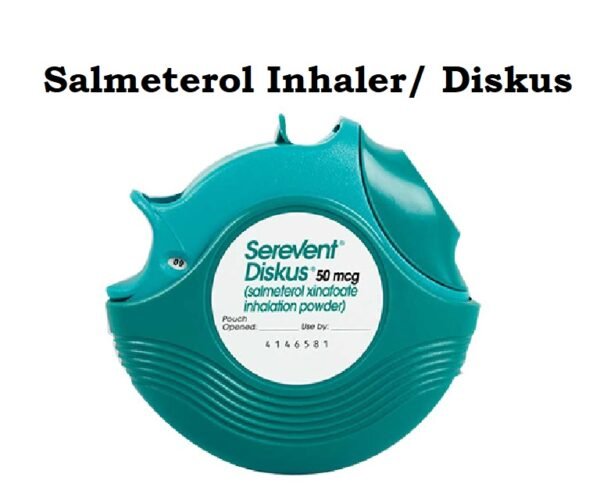Salmeterol Inhaler (Serevent Diskus) is a long-acting beta-2 agonist. It is used to relieve the symptoms of bronchospasm (cough, dyspnea, and wheezing) in patients with asthma and COPD.
Salmeterol Inhaler (Serevent Diskus) Uses:
-
Asthma and Bronchospasm:
- It is beneficial for treating reversible obstructive airway disease, which includes patients with symptoms of nocturnal asthma, in patients under the age of four. It also helps avoid bronchospasm when used in conjunction with an inhaled corticosteroid (ICS).
-
Chronic obstructive pulmonary disease:
- The maintenance therapy for bronchospasm and chronic obstructive pulmonary disease (COPD) are related (including emphysema and chronic bronchitis).
-
Exercise-induced bronchospasm:
- Exercise-induced bronchospasm (EIB) prophylaxis in individuals older than 4 years old (use in combination with an ICS in patients with persistent asthma).
Note: It is not recommended for treating severe bronchospasm.
Salmeterol Inhaler (Serevent Diskus) Dose in Adults
Note: It is not indicated for the relief of acute bronchospasm.
Salmeterol Inhaler (Serevent Diskus) Dose in the treatment of Asthma/ Bronchospasm:
-
Oral inhalation:
- Dry powder inhaler:
- Single inhalation (50 mcg) twice a day (~12 hours apart);
- maximum: 1 inhalation twice daily.
- Note: It must be highlighted that long-acting beta-2 agonists (LABAs) should not be used alone to treat asthma; rather, they should be used with inhaled corticosteroids.
- Dry powder inhaler:
Salmeterol Inhaler (Serevent Diskus) Dose in the treatment of Chronic obstructive pulmonary disease:
-
Oral inhalation:
- Dry powder inhaler: Single inhalation (50 mcg) will be taken twice a day (~12 hours apart);
- maximum: 1 inhalation twice a day.
Salmeterol Inhaler (Serevent Diskus) Dose in the treatment of Exercise-induced bronchospasm:
-
Oral inhalation:
- Dry powder inhaler: Additional doses should not be used for 12 hours or in people who are currently taking salmeterol twice day. A single inhalation (50 mcg) must be taken at least 30 minutes before exercise.
- The Asthma Guidelines (NAEPP 2007) caution against using LABAs for exercise-induced bronchospasm frequently or continuously since they may mask persistent asthma that is not well managed.
Salmeterol Inhaler (Serevent Diskus) Dose in Children
Note: Useless for treating severe bronchospasm.
Salmeterol Inhaler (Serevent Diskus) Dose in the maintenance treatment and prevention of Asthma:
-
Children ≥4 years and Adolescents:
- Oral inhalation (50 mcg/inhalation):
- One inhalation twice a day, ~12 hours apart.
- Note: For long-term asthma control, long-acting beta-agonists (LABAs) should not be administered as a monotherapy but rather in conjunction with inhaled corticosteroids.
- Oral inhalation (50 mcg/inhalation):
Salmeterol Inhaler (Serevent Diskus) Dose for preventing Exercise-induced bronchospasm:
-
Children ≥4 years and Adolescents:
- Oral inhalation (50 mcg/inhalation):
- Take one breath at least 30 minutes before working out.
- For 12 hours, there is no need for more doses.
- People who are already taking salmeterol twice a day shouldn't use it.
- Note: Because long-acting beta-agonists (LABAs) may mask poorly controlled persistent asthma, the NAEPP Asthma Guidelines (NAEPP 2007) oppose the repeated or chronic use of LABAs for exercise-induced bronchospasm.
- Oral inhalation (50 mcg/inhalation):
Salmeterol Inhaler (Serevent Diskus) Pregnancy Risk Category: C
- If administered during labor, beta-agonists can affect uterine contractionility.
- Uncontrolled asthma can lead to adverse pregnancy events, e.g. Increased risk of pre-eclampsia and preterm births, as well as low birth weight infants.
- Exacerbation of asthma or poor control of asthma could pose a greater risk to the fetus/maternal health than those that are associated with properly administered asthma medication.
- Salmeterol is a long-acting betaagonist that can be used to treat mild or severe persistent asthma in pregnant ladies.
Salmeterol use during breastfeeding:
- If salmeterol is found in breast milk, it is not predefined.
- Keep in mind the manufacturer. The decision to breastfeed during therapy must be made taking into account the risks to infants, the benefits to the infant and the benefits to the mother.
- Breastfeeding should be encouraged for women with asthma.
Salmeterol Dose in Kidney Disease:
No dosage adjustments are provided in the manufacturer's labeling.
Salmeterol Dose in Liver disease:
- No dosage adjustments are provided in the manufacturer's labeling (has not been studied).
- However, plasma levels may be increased and salmeterol is primarily cleared in the liver. It must be used with caution and monitor closely.
Side Effects of Salmeterol Inhaler (Serevent Diskus):
-
Central Nervous System:
- Headache
- Pain
Less Common Side Effects Of Salmeterol Inhaler (Serevent Diskus):
-
Cardiovascular:
- Hypertension
- Edema
-
Central Nervous System:
- Dizziness
- Sleep Disorder
- Anxiety
- Migraine
- Paresthesia
-
Dermatologic:
- Skin Rash
- Contact Dermatitis
- Eczema
- Urticaria
- Photodermatitis
- Pallor
-
Endocrine & Metabolic:
- Hyperglycemia
-
Gastrointestinal:
- Dyspepsia
- Gastrointestinal Infection
- Nausea
- Oropharyngeal Candidiasis
- Toothache
- Xerostomia
-
Hepatic:
- Increased Liver Enzymes
-
Infection:
- Influenza
-
Neuromuscular & Skeletal:
- Muscle Cramps
- Muscle Spasm
- Arthritis
- Arthralgia
- Muscle Rigidity
-
Ophthalmic:
- Conjunctivitis
- Keratitis
-
Respiratory:
- Nasal Congestion
- Bronchitis
- Throat Irritation
- Tracheitis
- Pharyngitis
- Cough
- Viral Respiratory Tract Infection
- Sinusitis
- Rhinitis
- Asthma
-
Miscellaneous:
- Fever
Contraindications to Salmeterol Inhaler (Serevent Diskus):
- Intolerance to salmeterol and any other formulation ingredient
- Extreme allergy to milk proteins
- Asthma monotherapy (using, for instance,
- Use without concurrent use of an inhaled corticosteroid
- Treatment for acute COPD, status asthmaticus, or other episodes.
- Canadian labeling: Additional contraindications not found in the US labeling
- A tachyarrhythmia is the presence
- There are limitations in documenting allergenic cross-reactivity with sympathomimetics.
- Cross-sensitivity can be possible due to similarities in chemical structure or pharmacologic actions.
Warnings and precautions
-
Deaths due to asthma: [US Boxed Warn]
- Due to the usage of long-acting beta-2 aldrenergic antagonists (LABAs), monotherapy, the number of deaths attributable to asthma has increased (without inhaled steroids).
- A large, placebo-controlled clinical trial showed that patients who received salmeterol in addition to their usual asthma treatment had an increase in deaths due to asthma. Background inhaled corticosteroids were not necessary.
- Large clinical trials have shown that LABAs can be used in combination with inhaled Corticosteroids in fixed doses.
- The likelihood of severe asthma-related events like hospitalizations, intubations, and death has not increased much.
- Salmeterol shouldn't be used as an adjuvant medication for asthma sufferers. This is for patients whose inhaled corticosteroids are not controlling their symptoms well enough.
- In the treatment of asthma, monotherapy with a LABA and an inhaled corticosteroid are contraindicated.
- Patients with asthma that is well controlled by low- or moderate-dose inhaled corticosteroids should not be given salmeterol.
- According to current recommendations, a LABA should be added after an inhaled corticosteroid.
- There is no evidence to suggest that LABA use increases the risk of death for patients suffering from COPD.
-
Bronchospasm
- Paradoxical bronchospasm can be caused by inhaled drugs. This could pose a danger to your life.
- This should not be confused with the inadequacy of the response.
- Paradoxical bronchospasm can be caused by using the medication.
-
Hypersensitivity
- An immediate hypersensitivity reaction, angioedema and rash, as well as underpinning anaphylaxis have been listed.
- If you experience symptoms of hypersensitivity, discontinue use immediately.
-
Deaths and serious effects:
- Avoid exceeding the recommended dosage or frequency of LABAs medications. Excessive use of sympathomimetics inhaled can cause serious adverse reactions, including fatalities.
-
Upper airway symptoms
- There have been reports of laryngeal spasms, discomfort, and edoema after usage (stridor and choking).
-
Cardiovascular disease
- Patients with heart disease (e.g. Beta-agonists can cause hypertension, arrhythmia, and coronary insufficiency.
- ECG changes may be caused by beta-2 agonists (e.g. T wave, prolongation or ST-segment depression, QTc interval prolongation, and/or T wave
-
Diabetes:
- Patients with diabetes mellitus should be treated with caution
- Beta-2 agonists are believed to raise serum glucose and worsen ketoacidosis, but the effects are usually temporary.
-
Exercise-induced bronchospasm
- The 2007 NIH Asthma Guidelines advise against using LABAs to treat bronchospasm brought on by exercise. LABAs can conceal persistent asthma that is ill-controlled.
-
Hepatic impairment
- Patients with hepatic impairment should not use it. However, plasma concentrations of salmeterol may increase in those with hepatic dysfunction.
-
Hyperthyroidism:
- Hyperthyroidism should not be treated with beta-2 agonists as they can stimulate thyroid activity.
-
Hypokalemia
- Hypokalemia patients should be treated with caution.
- Beta-2 agonists can decrease serum potassium, but the effect is often transient.
-
Seizures:
- Beta-agonists may result in CNS stimulation/excitation so it must be used cautiously in patients with seizure disorders.
Salmeterol: Drug Interaction
Note: Drug Interaction Categories:
- Risk Factor C: Monitor When Using Combination
- Risk Factor D: Consider Treatment Modification
- Risk Factor X: Avoid Concomitant Use
Risk Factor C (Monitor therapy) |
|
| Aprepitant | May elevate CYP3A4 substrates' serum concentration (High risk with Inhibitors). |
| AtoMOXetine | May enhance the tachycardic effect of Beta2-Agonists. |
| AtoMOXetine | May enhance the hypertensive effect of Sympathomimetics. AtoMOXetine may enhance the tachycardic effect of Sympathomimetics. |
| Atosiban | Beta2-Agonists may enhance the adverse/toxic effect of Atosiban. Specifically, there may be an increased risk for pulmonary edema and/or dyspnea. |
| Beta-Blockers (Beta1 Selective) | May diminish the bronchodilatory effect of Beta2-Agonists. Of particular concern with nonselective beta-blockers or higher doses of the beta1 selective betablockers. |
| Betahistine | May diminish the therapeutic effect of Beta2-Agonists. |
| Cannabinoid-Containing Products | May enhance the tachycardic effect of Sympathomimetics. Exceptions: Cannabidiol. |
| Clofazimine | May elevate CYP3A4 substrates' serum concentration (High risk with Inhibitors). |
| CYP3A4 Inhibitors (Moderate) | May slow down CYP3A4 substrate metabolism (High risk with Inhibitors). |
| CYP3A4 Inhibitors (Moderate) | Salmeterol serum levels can rise. Grapefruit juice is an exception. |
| Doxofylline | Sympathomimetics may enhance the adverse/toxic effect of Doxofylline. |
| Duvelisib | May increase the serum concentration of CYP3A4 Substrates (High risk with Inhibitors). |
| Erdafitinib | May increase the serum concentration of CYP3A4 Substrates (High risk with Inhibitors). |
| Fosaprepitant | May increase the serum concentration of CYP3A4 Substrates (High risk with Inhibitors). |
| Fosnetupitant | May increase the serum concentration of CYP3A4 Substrates (High risk with Inhibitors). |
| Guanethidine | Could make sympathomimetics more arrhythmogenic. Guanethidine might make sympathomimetic drugs more hypertensive. |
| Haloperidol | The QTcprolonging effect of haloperidol may be enhanced by QT-prolonging agents (Indeterminate Risk - Caution). |
| Larotrectinib | May elevate CYP3A4 substrates' serum concentration (High risk with Inhibitors). |
| Loop Diuretics | Beta2-Agonists may enhance the hypokalemic effect of Loop Diuretics. |
| Monoamine Oxidase Inhibitors | May enhance the adverse/toxic effect of Beta2-Agonists. |
| Netupitant | May elevate CYP3A4 substrates' serum concentration (High risk with Inhibitors |
| Palbociclib | May elevate CYP3A4 substrates' serum concentration (High risk with Inhibitors |
| QT-prolonging Agents (Highest Risk) | QT-prolonging Agents (Indeterminate Risk - Caution) may enhance the QTc-prolonging effect of QT-prolonging Agents (Highest Risk). Management: Monitor for QTc interval prolongation and ventricular arrhythmias when these agents are combined. Patients with additional risk factors for QTc prolongation may be at even higher risk. |
| Simeprevir | May increase the serum concentration of CYP3A4 Substrates (High risk with Inhibitors). |
| Solriamfetol | Sympathomimetics may enhance the hypertensive effect of Solriamfetol. |
| Sympathomimetics | May enhance the adverse/toxic effect of other Sympathomimetics. |
| Tedizolid | May enhance the hypertensive effect of Sympathomimetics. Tedizolid may enhance the tachycardic effect of Sympathomimetics. |
| Thiazide and Thiazide-Like Diuretics | Beta2-Agonists may enhance the hypokalemic effect of Thiazide and Thiazide-Like Diuretics. |
| Tricyclic Antidepressants | May enhance the adverse/toxic effect of Beta2-Agonists. |
Risk Factor D (Consider therapy modification) |
|
| Cocaine (Topical) | May enhance the hypertensive effect of Sympathomimetics. Management: Consider alternatives to use of this combination when possible. Monitor closely for substantially increased blood pressure or heart rate and for any evidence of myocardial ischemia with concurrent use. |
| Linezolid | May enhance the hypertensive effect of Sympathomimetics. Management: Reduce initial doses of sympathomimetic agents, and closely monitor for enhanced pressor response, in patients receiving linezolid. Specific dose adjustment recommendations are not presently available. |
| Stiripentol | May elevate CYP3A4 substrates' serum concentration (High risk with Inhibitors. Management: Due to the increased potential for side effects and toxicity, stiripentol should not be used with CYP3A4 substrates that are thought to have a narrow therapeutic index. Use of stiripentol with any CYP3A4 substrate necessitates closer observation. |
Risk Factor X (Avoid combination) |
|
| Beta2-Agonists (Long-Acting) | May intensify the negative or harmful effects of additional beta2-agonists (Long-Acting). |
| Beta-Blockers (Nonselective) | May lessen beta2-agonists' bronchodilator effects. |
| Conivaptan | May increase the serum concentration of CYP3A4 Substrates (High risk with Inhibitors). |
| CYP3A4 Inhibitors (Strong) | May increase the serum concentration of Salmeterol. |
| Fusidic Acid (Systemic) | May increase the serum concentration of CYP3A4 Substrates (High risk with Inhibitors). |
| Idelalisib | May increase the serum concentration of CYP3A4 Substrates (High risk with Inhibitors). |
| Loxapine | The negative or hazardous effects of loxapine may be increased by medications for airway disease. More precisely, the usage of Agents to Treat Airway Disease is probably a symptom of someone who is more likely to be susceptible to substantial bronchospasm from inhaling loxapine. Management: This only applies to the inhaled version of loxapine sold under the brand name Adasuve. The non-inhaled loxapine formulations are exempt from this rule. |
| Tipranavir | Salmeterol serum levels can rise. |
Monitoring parameters:
- FEV1
- Peak flow
- blood pressure
- heart rate
- CNS stimulation
- serum potassium
- glaucoma
- hypersensitivity reactions
- decreased bronchodilator response
How to administer Salmeterol Inhaler (Serevent Diskus)?
- Oral inhalation: Only oral inhalation is permitted.
- Before using it for the first time, immediately remove from sealed packet.
- Before taking the dose, exhale fully.
- No need to breathe into the Diskus gadget.
- Use only when flat and level.
- Take a rapid, deep breath in via the Diskus, hold it for 10 seconds or however long feels comfortable, and then gently let it out.
- Diskus should be kept dry and should not be used with a spacer device or a washed mouthpiece.
Mechanism of action of Salmeterol Inhaler (Serevent Diskus):
- With no impact on heart rate, selective activity on beta-2 receptors relaxes the smooth muscles of the bronchi. Localized in the lung, salmeterol.
The onset of action:
- Asthma: 30 to 48 minutes,
- COPD: 2 hours
Peak effect:
- Asthma: 3 hours,
- COPD: 2 to 5 hours
Duration: 12 hours Systemic Absorption following inhalation:
- Undetectable to poor
Protein binding:
- 96%
Metabolism:
- Hepatic; hydroxylated via CYP3A4
Half-life elimination:
- 5.5 hours
Time to peak serum concentrations:
- About 20 minutes
Excretion:
- Feces (60%);
- Urine (25%)
International Brands of Salmeterol:
- Serevent Diskus
- Serevent Diskhaler Disks
- Serevent Diskus
- Aeromax
- Axinat
- Bexitrol HFA
- Metrovent
- Neovent
- Ping Te
- Qitai
- Salmerol
- Serevent
- Serevent Inhaler and Disks
- Serevent Rotadisks
- Serobid
- Vertine
Salmeterol Brand Names in Pakistan:
Salmeterol Inhaler 25 mcg/actu |
|
| SEREVENT | GLAXOSMITHKLINE |




